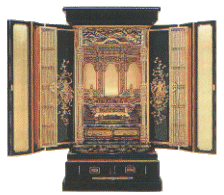Hiroshima Buddhist altars are a traditional wood craft created during a process
comprising such skills as including the carving, painting, inlay work, plating and joinery
work.
Manufacture of the presently known form of Buddhist altars started, when a craftsman
specialized in lacquer work accompanied the Asano family appointed feudal lord of Aki from
Kishu and thus introduced the technique from Kyoto and Osaka. Anyhow, it started during the
18th century.
Later, these objects became known under the name Akimonto and the craft flourished before a
background of its spread in the Jodo Shinshu Buddhist sect. By the Meiji period Hiroshima
had turned almost completely into a "Buddhist altar" city.
Presently many of the craftsmen have grown old and production stagnates. Yet, there are
still as many as 700 craftsmen in the area of Hiroshima and Fukushima, who built annually
about 5,000 altars. The shipment value of these altars amounts to 32 billion and thus
constitutes 15% of the national share.
In 1978 it has been designated a traditional craft of Hiroshima Prefecture.
|
 |

